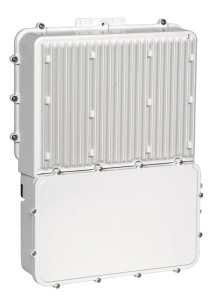Oct 22 2009
New Platform Enables 20 Mbps FTTN-Based Broadband Services in Advance of Fiber Deployment
ADTRAN, Inc. (NASDAQ: ADTN), a leading supplier of next-generation broadband solutions, today announced the industry's first sealed DSLAM with an integrated bonded copper uplink. The Total Access 1148A-DMT integrates both bonded copper and fiber uplinks into a sealed DSLAM design, enabling service providers to rapidly and cost-effectively accelerate the deployment of enhanced broadband services by leveraging the existing copper infrastructure—while providing a seamless migration path to a Fiber to the Node (FTTN) architecture.
 ADTRAN Total Access 1148A-DMT
ADTRAN Total Access 1148A-DMT
ADTRAN's Total Access 1148A-DMT broadband access system provides an innovative approach to the successful deployment of high-speed broadband services. Leveraging ADTRAN's market leadership in Carrier Ethernet and sealed FTTN DSLAMs, the Total Access 1148A-DMT is a sealed FTTN DSLAM that provides two transport options: an integrated bonded copper uplink option capable of providing >100 Mbps or a traditional Gigabit Ethernet fiber uplink. Instead of bonding multiple T1/E1s together using ATM IMA, the Total Access 1148A-DMT uses Ethernet in the First Mile (EFM) to bond multiple ADSL2+ pairs. This enables more than 25 times the per-pair backhaul bandwidth of traditional copper-fed DSLAMs. With this solution, service providers can enable 20 Mbps service offerings that were once only practical with FTTx architectures.
Consumers are continuing to demand higher bandwidth services to support various applications, from peer-to-peer file sharing to online music and video downloads. Traditional consumer broadband is largely asymmetrical in nature, providing significantly higher bandwidth downstream than upstream. High downstream bandwidth requirements have historically driven service providers to install fiber—simply because there were no copper-based transport solutions available to match the consumer offerings.
“Access to fiber is not ubiquitous and deploying new fiber is not always a viable economic solution. The ADTRAN Total Access 1148A-DMT allows service providers to maximize the use of their existing copper plant to meet the increasing demand for bandwidth,” said Teresa Mastrangelo, principal analyst, Broadband Trends. “Leveraging the asymmetrical nature of ADSL2+ as a transport technology, this innovative solution allows service providers to defer their investment in fiber but still offer competitive bandwidth solutions up to 20 Mbps per user. The Total Access 1148A-DMT also has integrated Gigabit Ethernet fiber uplinks which further protects the investment and allows the service provider to transition to fiber at its own pace and without the need for additional equipment.”
“ADTRAN's goal is to provide an innovative approach to the needs of service providers, allowing them to address the demand for a variety of services in the most efficient and cost-effective means possible,” said Mike Martin, director of product management, ADTRAN Carrier Networks Division. “While there are a limited number of other solutions available that offer bonded copper to a DSLAM, they are all two-vendor, two-platform solutions — which greatly increase both capital cost and operational complexity. The Total Access 1148A-DMT is a single platform solution, which integrates copper transport capability into our industry-leading sealed DSLAM portfolio. This integration provides an economical, operationally friendly solution for shortening loops to deliver high-bandwidth services. This allows service providers to defer the expense of deploying fiber while remaining competitive with alternative broadband offerings.”
ADTRAN's market-leading Total Access 1100 Series sealed FTTN DSLAM portfolio eliminates the need for expensive cabinet enclosures, inefficient heat exchangers and costly site construction. By providing innovative line powering over the ADSL2+ copper transport pairs, service providers can also eliminate the need for power and batteries at remote nodes, greatly reducing the cost to deploy a node. This innovative design allows carriers to cost-effectively reduce loop lengths to maximize the performance of DSL, efficiently delivering fiber-like performance across existing copper transport.